IFK Norrköping is a prominent football club based in Sweden. With a rich history dating back to its foundation in 1897, the club has not only established itself as a force in Swedish football but has also nurtured through some young talent from its youth development program. Emil Roback is one player who spent time in the IFK Norrköping youth system. The young Swedish forward moved on to Hammarby before signing for Serie A giants, AC Milan. Roback returned to Norrköping on loan in 2023, allowing him to get some valuable first-team experience.
IFK Göteborg is another Swedish club with a tremendous footballing heritage and is well-known for producing talented players. One recognisable name who has graduated from the Göteborg youth system is Sam Larsson, who moved to play in the Eredivisie for Herenveen and Feyenoord upon leaving his homeland.
The U19 Allsvenskan is drawing to a close with a compelling title race between IFK Norrköping and IFK Göteborg playing out. The former currently sit top of the league with the best defence. Meanwhile, Göteborg find themselves in second place but possess one of the best attacks, having netted 56 times so far this season.
This tactical analysis piece will take the form of a scout report where we will analyse the Norrköping defensive structure and why it has been so good this season. We will then move on to look at Götebog’s attacking tactics and explore why they have been able to score so many goals this season.
Norrköping’s exemplary defence:
A solid defensive structure
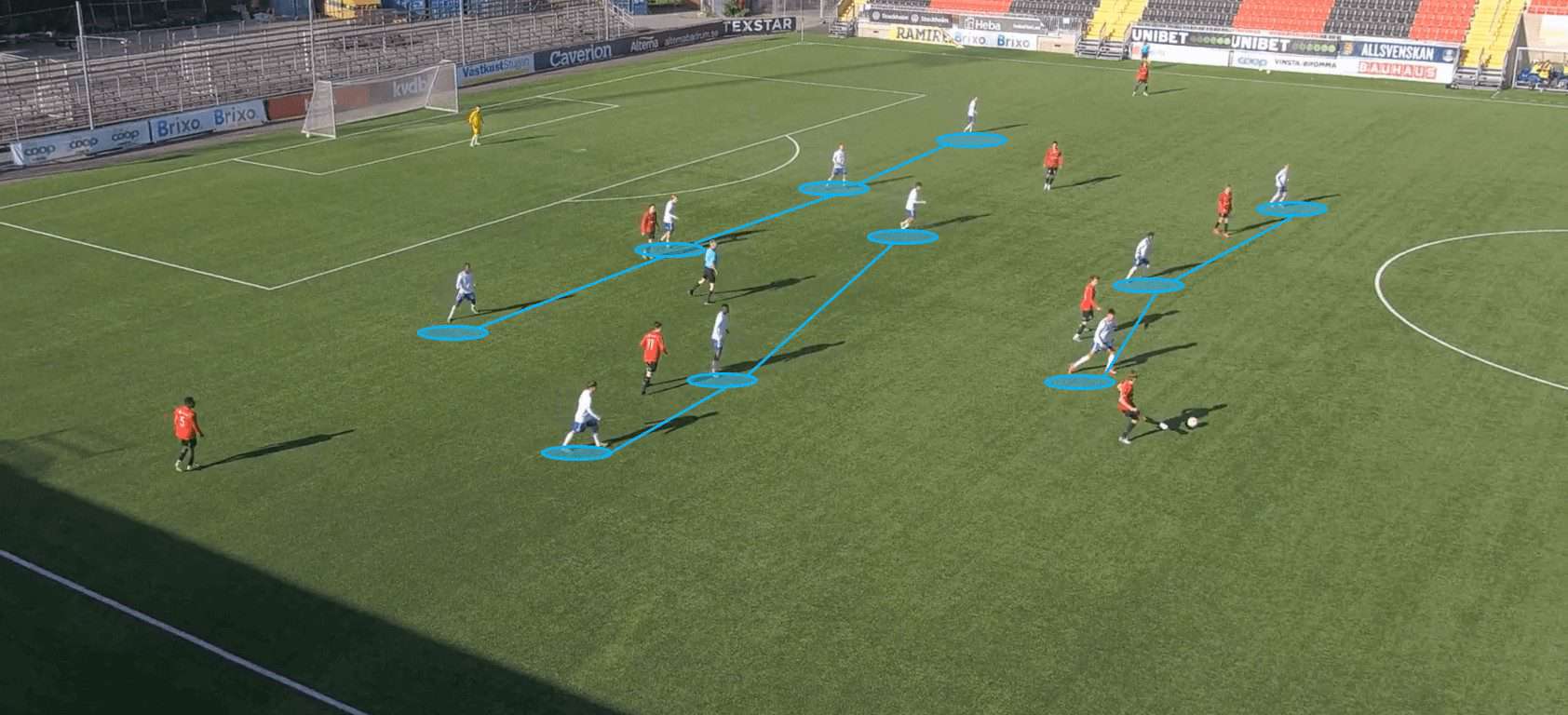
Norrköping U19 have the best defensive record in the league this season, having only conceded 20 goals so far. This is largely because the team works incredibly effectively as a cohesive unit in the defensive phase. As the image above demonstrates, Norrköping primarily adopts a 4-3-3 shape when they are defending. This involves the midfield and front three remaining compact and blocking off the passing lanes in central areas. This acts as a trap to force the opposition to move the ball out to the wide areas, where Norrköping will look to initiate an intense press to force their opponents back into their own half.
The presence of three midfielders enhances the team’s ability to press and regain possession in the central zones. The Norrköping midfield trio can apply coordinated pressure on the opposition’s midfielders and prevent them from establishing a rhythm in their build-up play. The additional midfield support also allows for effective ball recovery and interception opportunities, enabling the team to regain possession swiftly and launch counterattacks or initiate controlled build-up play from deeper areas.
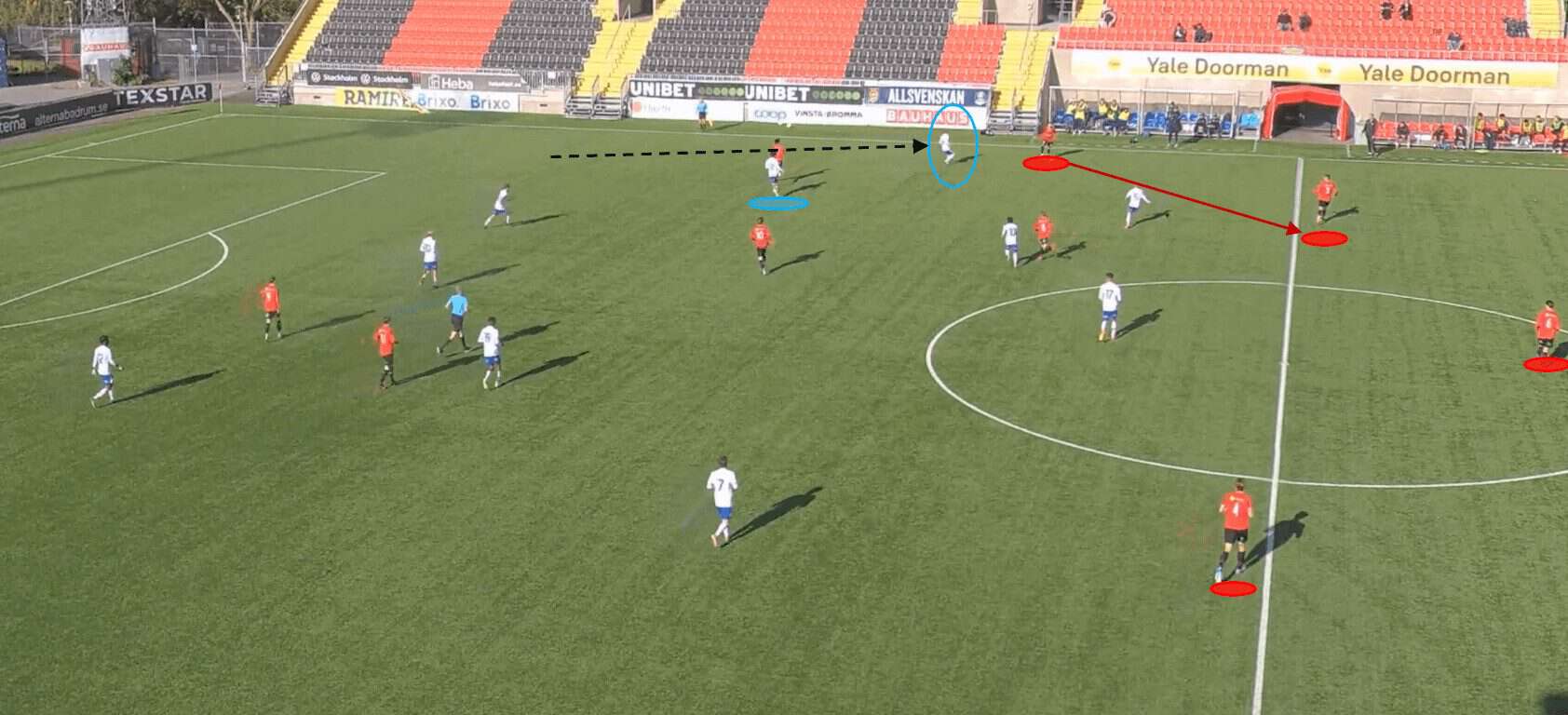
Once the ball is moved out to the wide areas, the Norrköping press springs into action, as we can see here. Jesper Lindvall, the left back, is the first player who initiates intense pressure on the opponent to either regain possession or force them to play backwards. Additionally, as Lindvall moves out of his position at left-back, one of the midfield three moves to fill in this space, ensuring the opposition cannot utilise this to their own advantage.
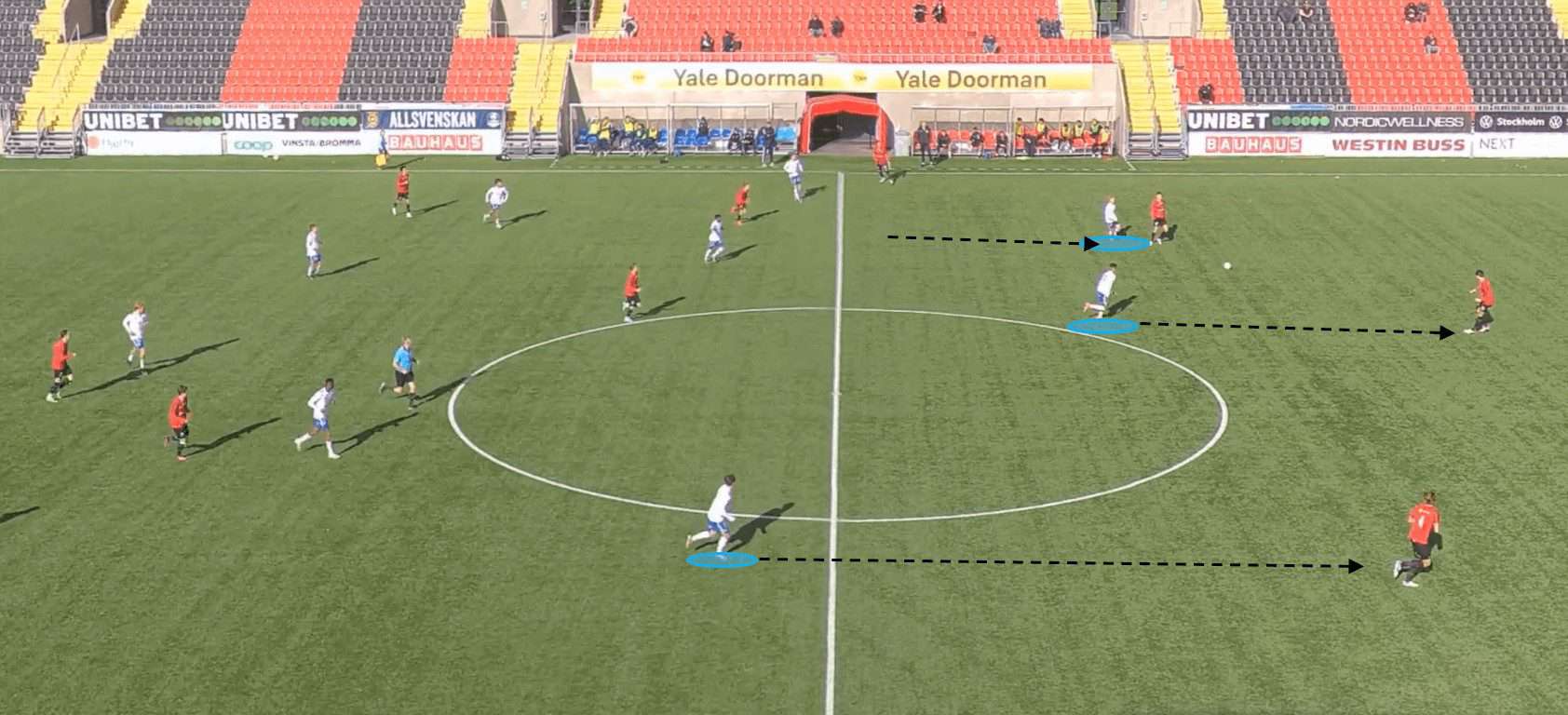
Furthermore, as Norrköping begin to press, they force the opponents backwards. This enables them to dictate the tempo of the game and control the territorial advantage. By confining the opponent to their own defensive third, Norrköping U19 can limit their options for progressive ball circulation and restrict their ability to build sustained attacks.
This territorial dominance often leads to increased ball recoveries in advantageous positions. Additionally, it facilitates quick transitions from defence to attack and places the opposing team under constant pressure, potentially resulting in defensive errors and goalscoring opportunities.
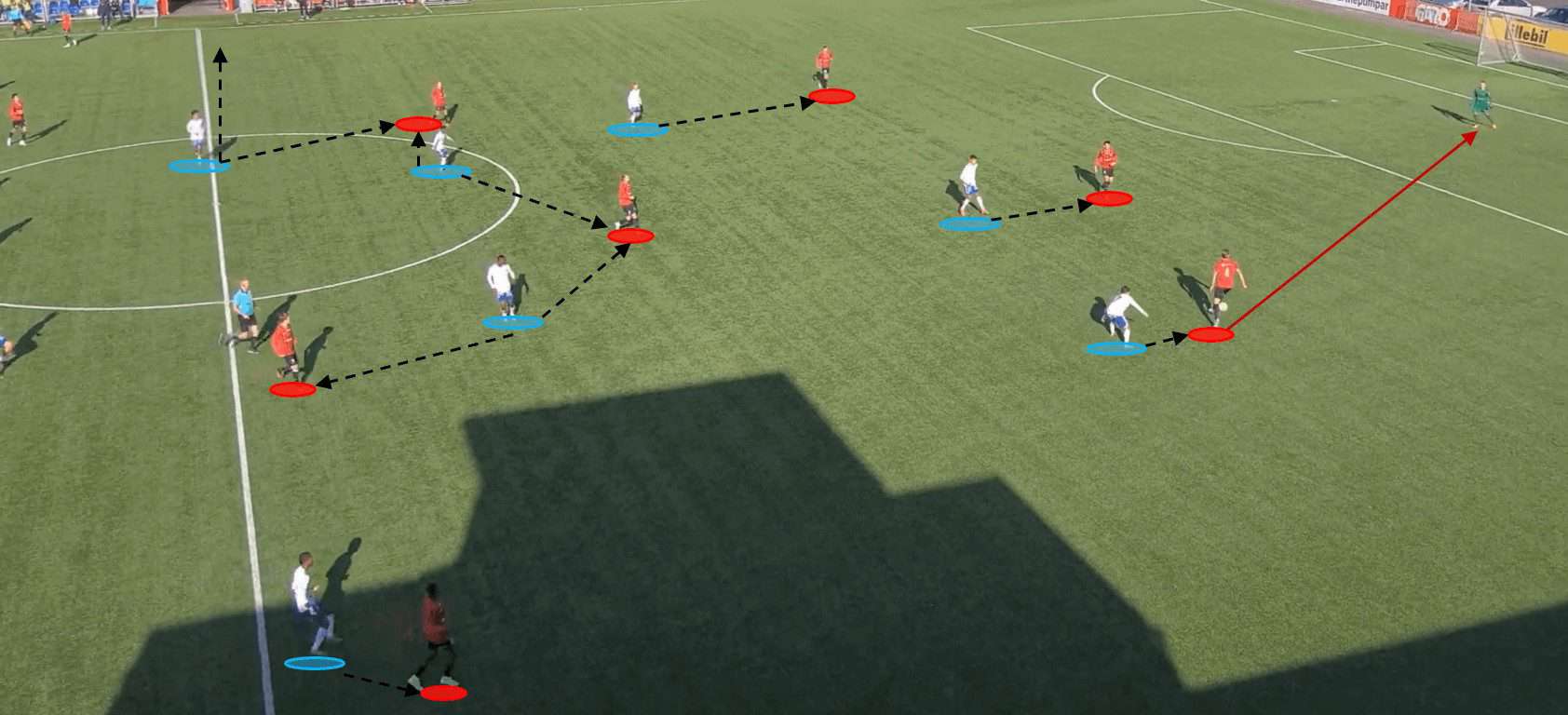
As we can see here, Norrköping have forced their opponents into passing back to the goalkeeper. The team in blue and white then look to close off passing lanes to prevent the opposition from playing out of defence. This example demonstrates how Norrköping U19s strategically structure themselves to ensure each player can put an opponent under instant pressure, which, of course, has the desired effect of forcing them to play long passes. Pressurising the goalkeeper into hitting a long pass increases the likelihood of Norrköping forcing a turnover via either winning the aerial battle or winning the ground duels.
Effective transitions
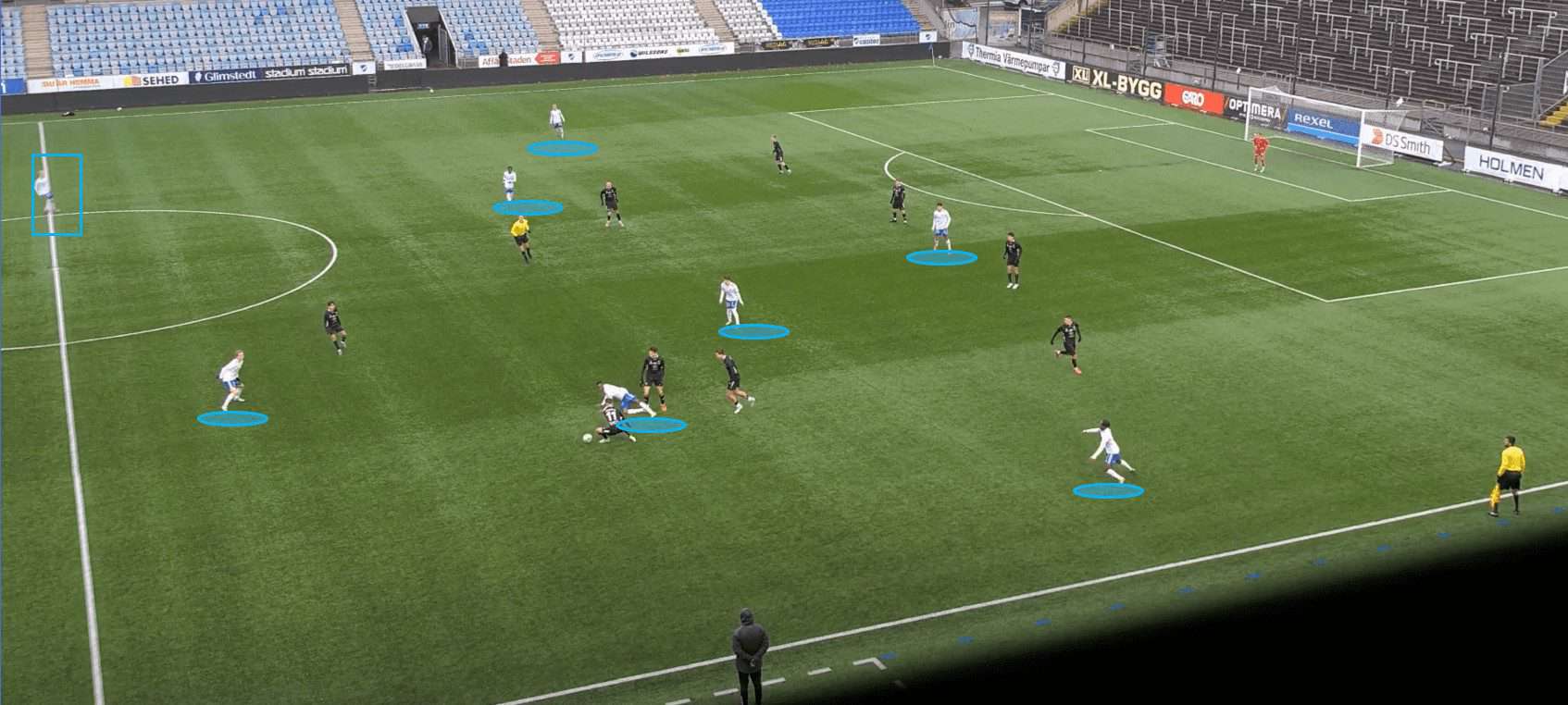
Moreover, even in the transition from attack to defence, it is challenging for opponents to catch Norrköping off guard. The team is incredibly well organised, and every player is committed to tracking back defensively. When they are in the attacking phase, the Swedish U19 league leaders like to commit numbers forward, but once again, they are strategic in doing so.
Typically, they like to get eight of the ten outfield players advanced into the opposition half, leaving only the two centre-backs on hand to recycle possession or make recovery runs. The full-backs work in tandem, depending upon which flank Norrköping are building their attack.
For example, here we can see that the left back, highlighted in the blue square, has not pushed up as high due to his team attacking down the right. This means he can track back much quicker should the team lose possession; additionally, should the opponent execute a switch of play, he can potentially intercept the ball and halt the counterattack.
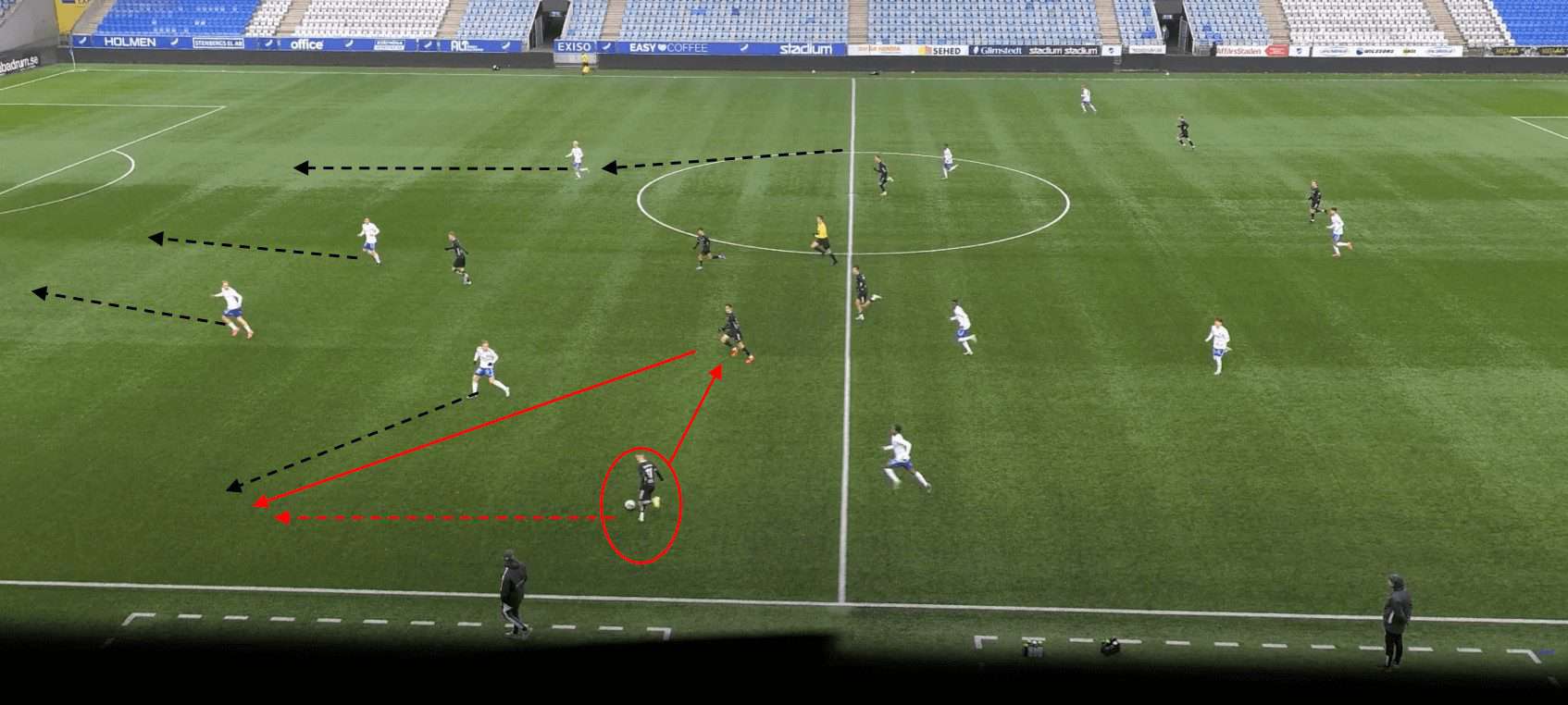
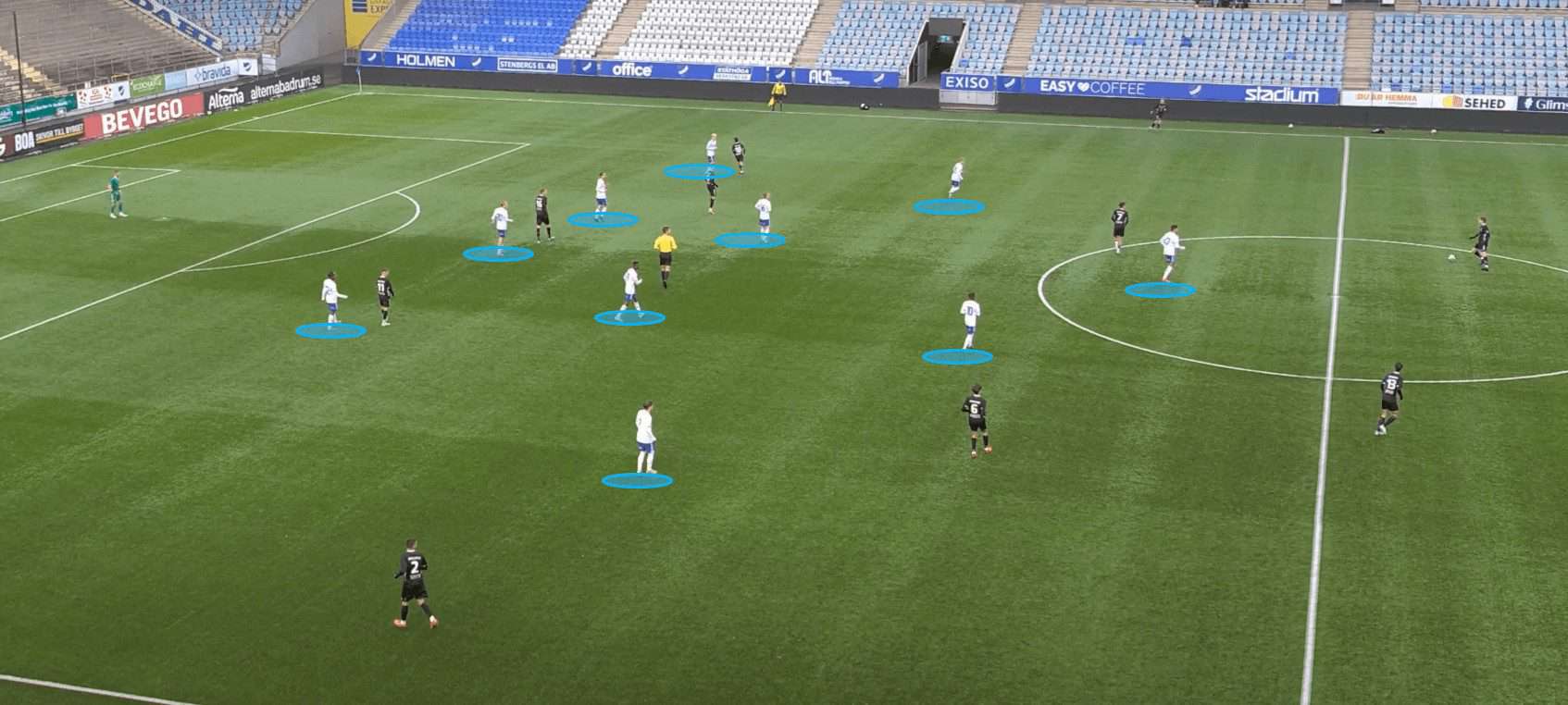
When they have lost possession, Norrköping U19 mostly look to fall back into their defensive shape rather than engage in counterpressing, as shown here. By retreating into a structured defensive formation, the team can regain positional balance and ensure that all defensive players are adequately positioned to nullify the opponent’s attacking threats. This offers more defensive stability and serves as a safeguard against the risk of being caught out of position and vulnerable to rapid offensive transitions, thereby reducing the likelihood of conceding goals due to defensive disorganisation.
Additionally, quickly adopting their defensive shape enables Norrköping to regroup and reestablish a solid defensive foundation, facilitating better coordination among the defensive players. Improved defensive cohesion allows for effective organisation, ensuring that the team remains vigilant and responsive to the movements of the opposition’s attacking players. This is a good way of preventing the opposition from exploiting potential defensive gaps and maintaining a heightened level of defensive awareness throughout the game.
Possible weaknesses
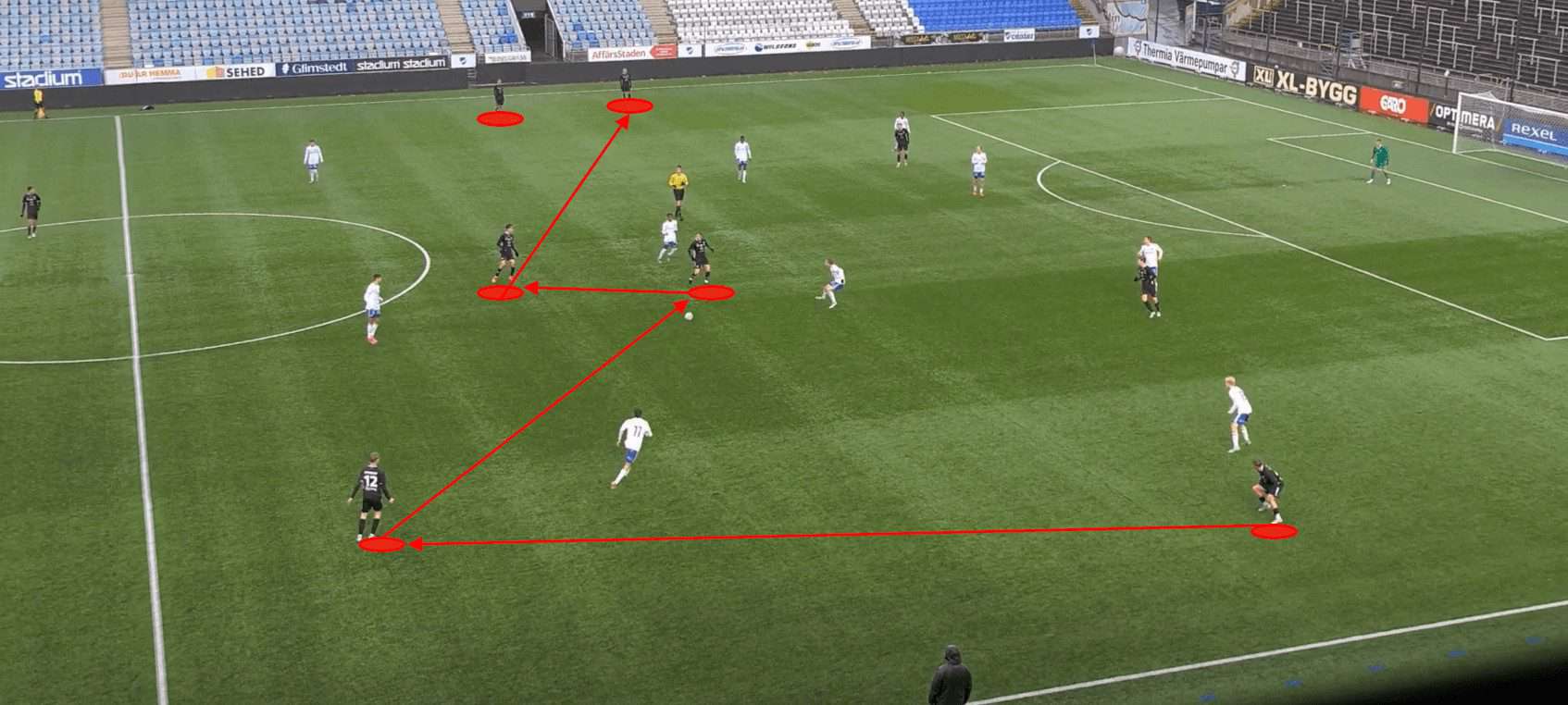
Although it’s rather difficult, it is not impossible to break through Norrköping’s defensive structure. This is especially possible later on in games as the team does start to fatigue a little since they utilise an intense way of playing. Here, we can see that they have been a little slow to get back into their defensive shape. As the opposition starts to move the ball around quickly and effectively, gaps begin to emerge, offering a potential way through the Norrköping defence.
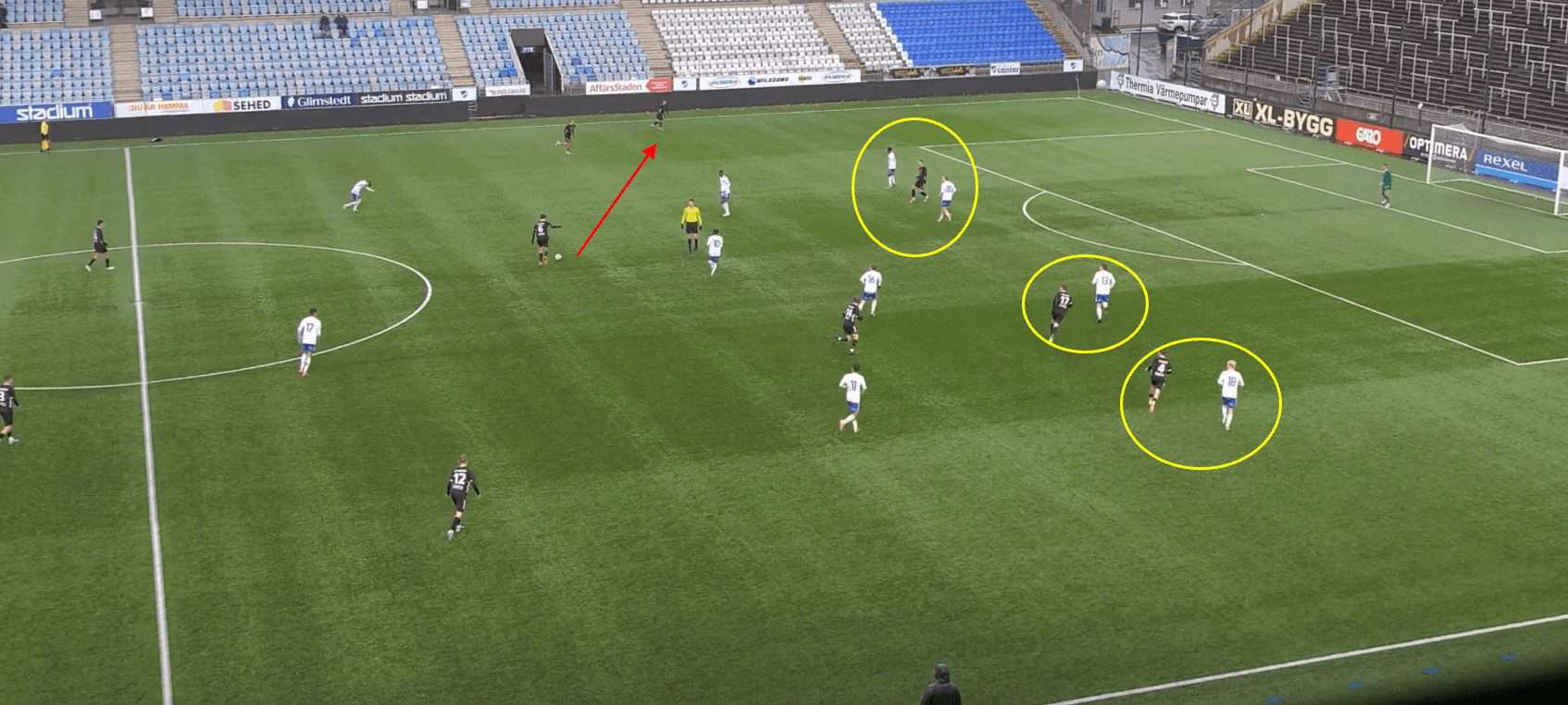
As we can see here, the Örebro front three positions themselves very narrowly in the attacking phase. The left winger occupies both the Norrköping right back and right centre back, meaning there is a vast amount of space available in the wide area. This is an issue with utilising a narrow and compact defensive shape, gaps occur down the flanks, and it can be difficult for the full-backs to deal with 1v1 situations.
In this situation, Kia Shemsu, the Norrköping U19 right back, is caught in two minds, whether to press the opposition winger when he receives the ball or to stay and keep an eye on the forward positioned near him.
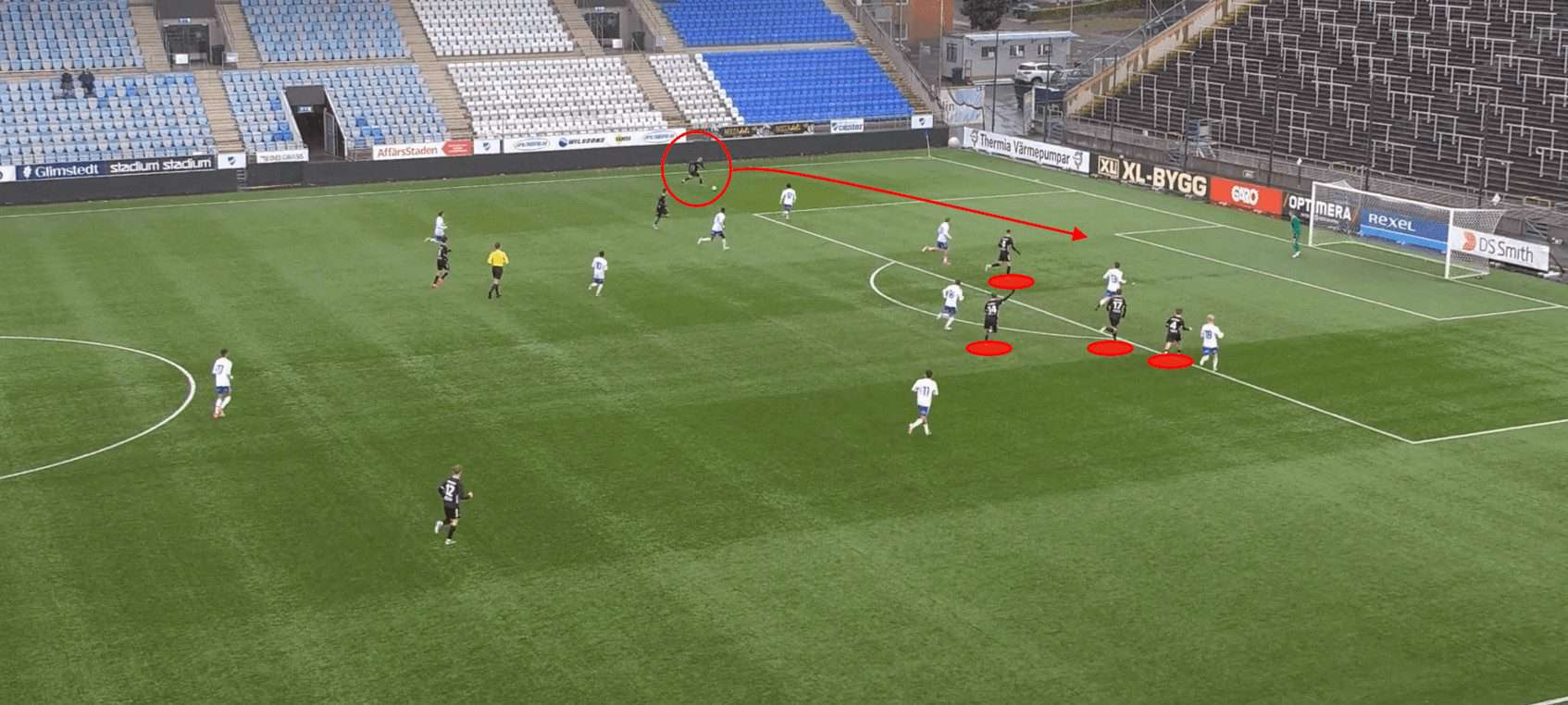
Eventually, Shemsu decides to address the situation and moves out to put pressure on the opponent, but it is too late. The space available allows Örebro to successfully get a cross into the box, which is turned goalwards by one of their forward players.
This does show that it is possible to penetrate Norrköping’s defensive structure by using their own tactics against them. The three Örebro forwards positioning themselves narrowly force the Norrköping back four to follow suit, leaving spaces in the wide areas for crosses to be whipped in, leading to goalscoring opportunities.
The main man
One of the standout players for Norrköping is centre-back Felix Stenman. The defender has been in fine form this season, putting in some impressive performances that go a long way to explain why his team have been so effective from a defensive standpoint.
Standing at 183 cm tall, the young defender possesses an impeccable aerial ability which has seen him winning 2.5 of the 3.8 aerial duels he engages in per 90.
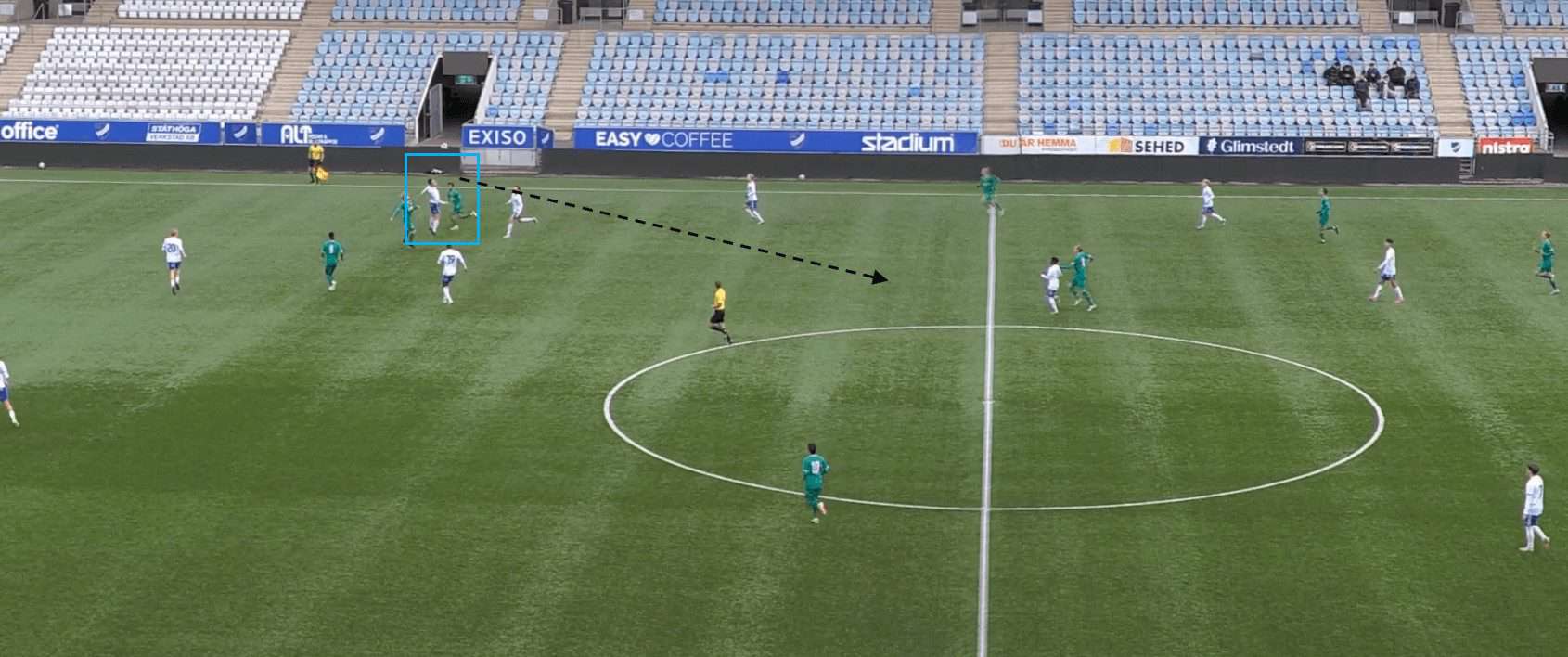
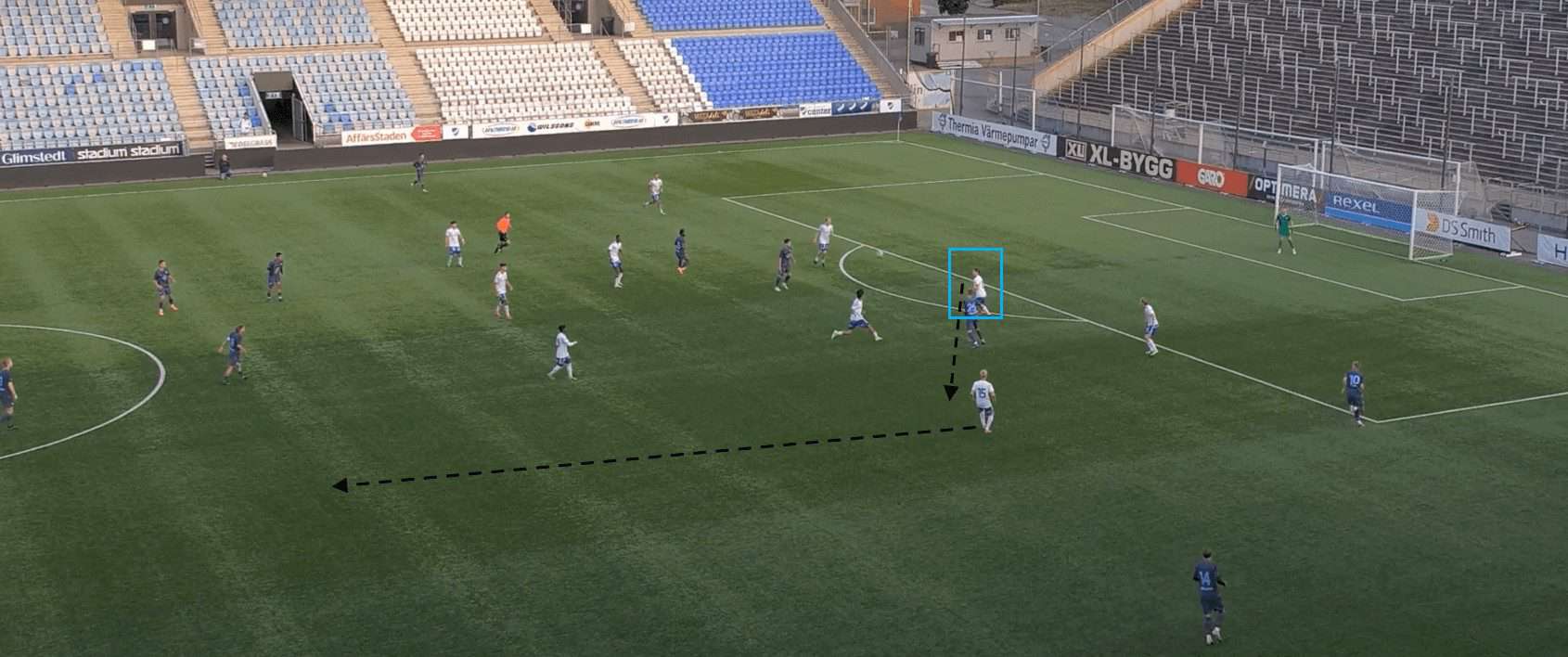
We can see in both examples here that Stenman is able to control his headers very well and can primarily direct them towards a teammate, which allows Norrköping to potentially transition from defence to attack very quickly. Despite his young age, the 19-year-old is a commanding aerial presence in defence. This is especially useful when Norrköping are dealing with crosses and set pieces.
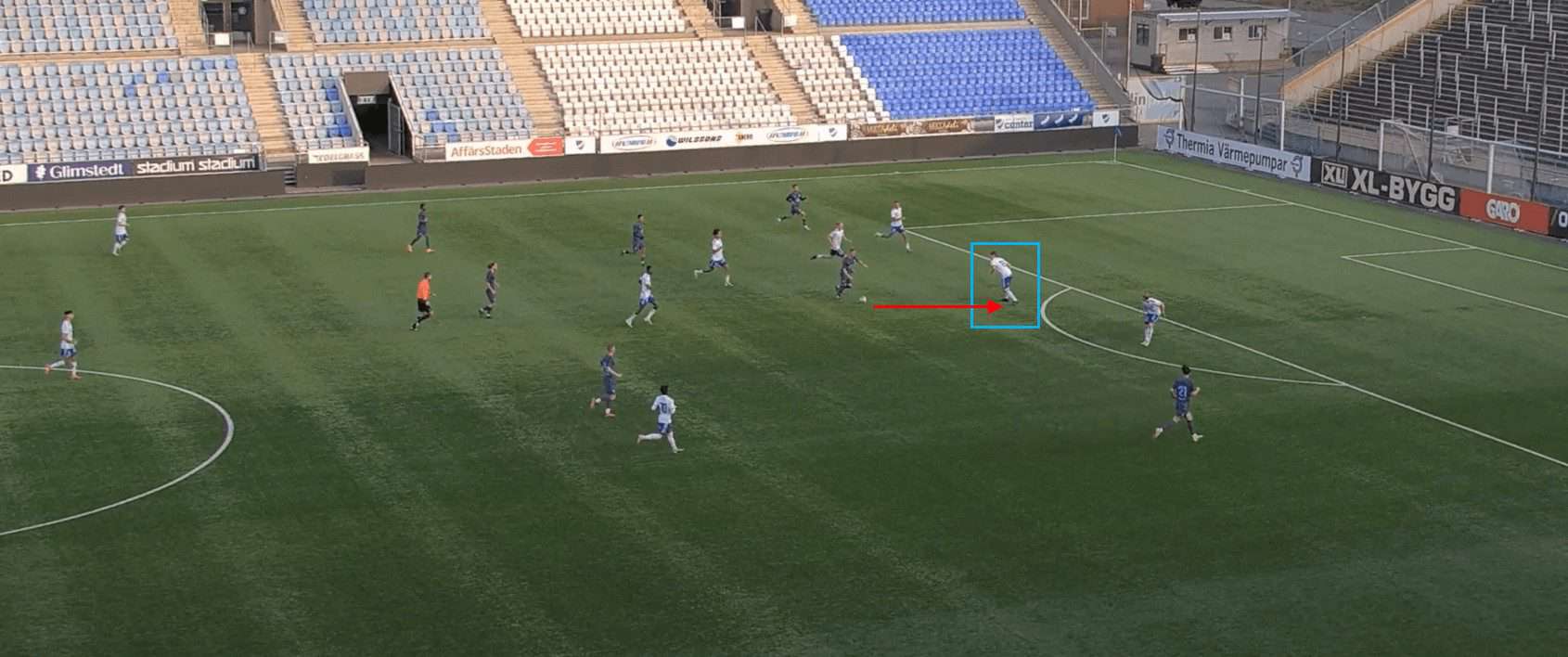
Additionally, he is equally as strong in the ground duels, winning 0.85 per 90. Stenman is willing to use his body positioning and orientation to put in blocks and make vital interceptions. As we can see in the example above, he does not stick too closely to his opponent, preferring to trust his own ability in the 1v1s.
Göteborg’s potent attack:
Press, press, press
For the remainder of this scout report, we will look into Göteborg U19’s attacking threat and discuss why they have been able to find the back of the net so well this season.
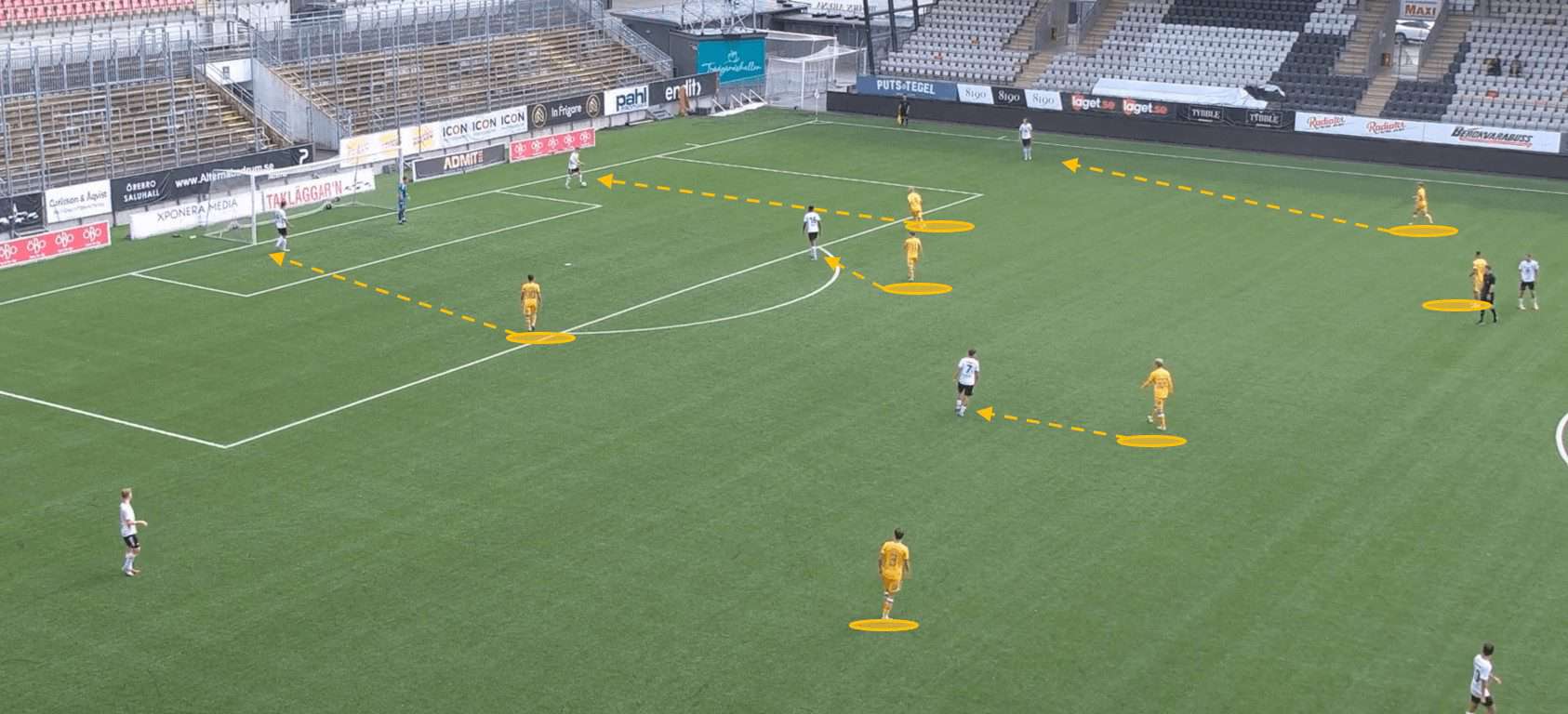
The first thing to note about Göteborg’s attacking threat actually stems from their defensive work. They look to prevent the opposition from playing out of defence by pressing very high, as we can see above. There are seven Göteborg U19 players ready to put instantaneous pressure on their opponents as they look to build an attack from the back.
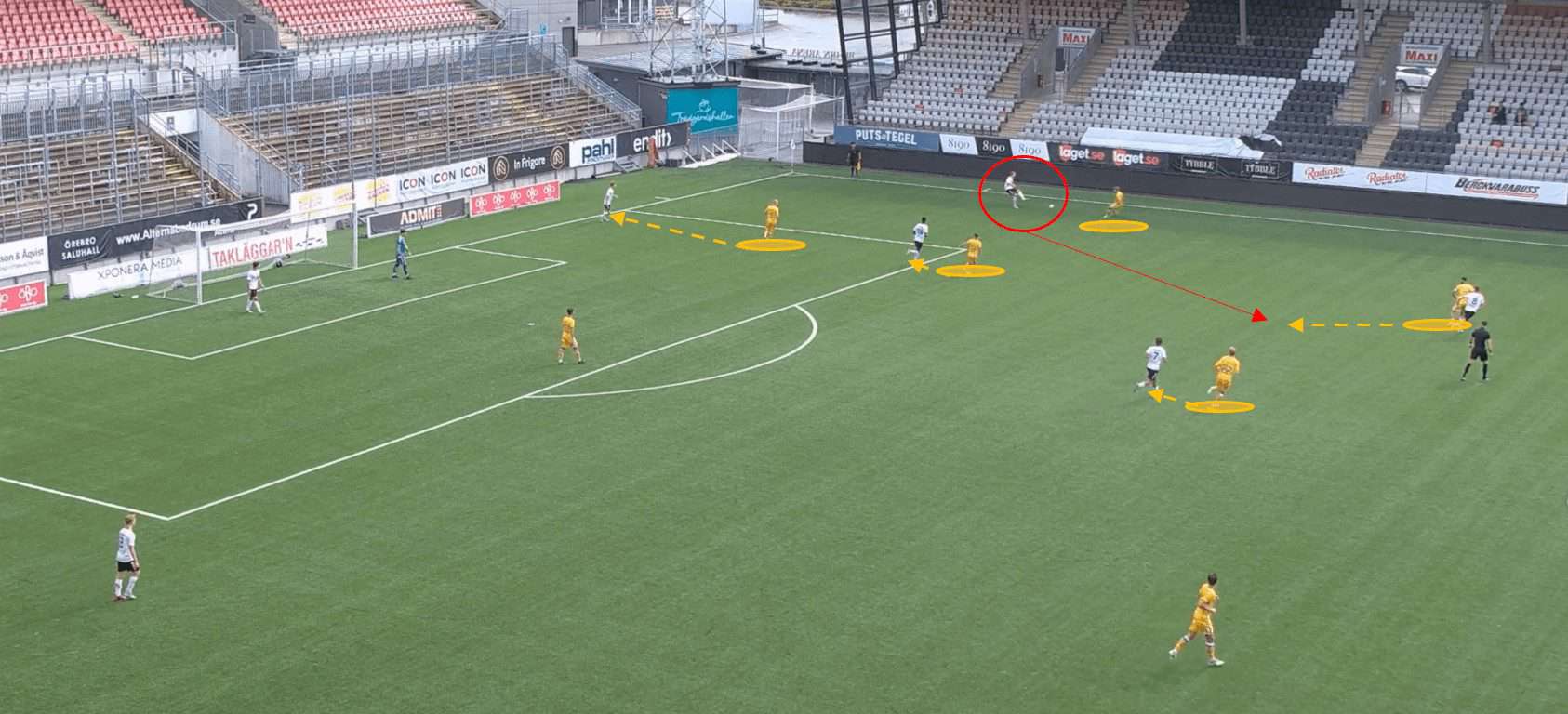
This proves to be incredibly fruitful as, with no open passing lanes, the opposition full-back hits a rather hopeful pass into space which is promptly picked up by a Göteborg player.
Regaining possession in the opposition half through this intense high pressing disrupts the organisation of the opposing team, creating the opportunity for quick transitions that favour the attacking team. This means the Göteborg team can exploit spaces and gaps left by the opposition, facilitating the ability to break through the defensive lines and the creation of numerical overloads in critical areas leading to goalscoring opportunities.
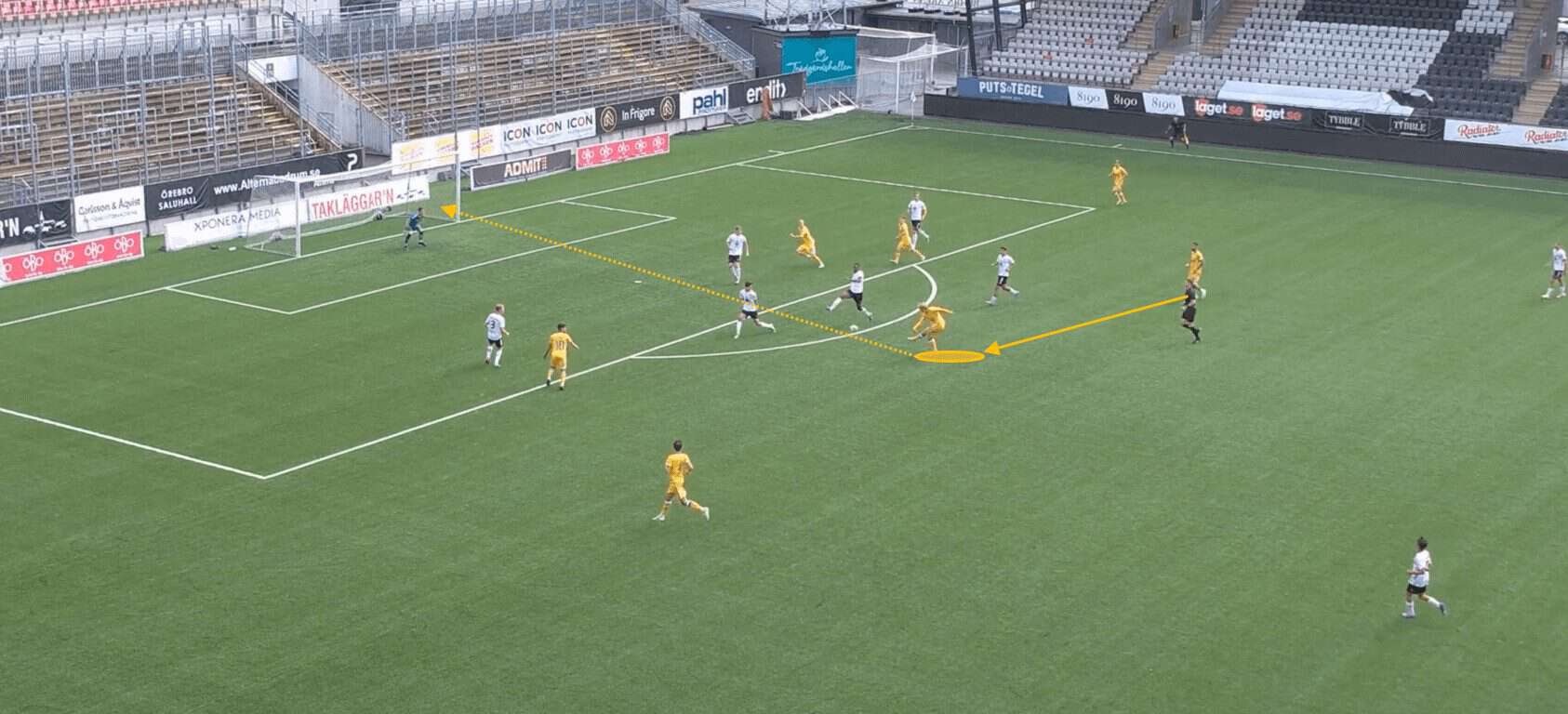
The turnover of possession then allows Göteborg to pass the ball to their talented central midfielder Noah Tolf. The young midfield maestro then executes a well-struck shot from the edge of the area into the bottom corner. Allowing their midfielders to shoot from range is something that is another key element of this team’s attacking play.
On the one hand, it may seem risky to promote playing long shots, but Göteborg mostly looks to utilise this when they force a turnover in the attacking half. By taking the opportunity to fire quick shots at goal, it takes advantage of the time and space due to the opposition being caught out of position. Additionally, these shots may catch the opposition goalkeeper off guard, increasing the likelihood of hitting the back of the net.
Creating space by swift link-up play
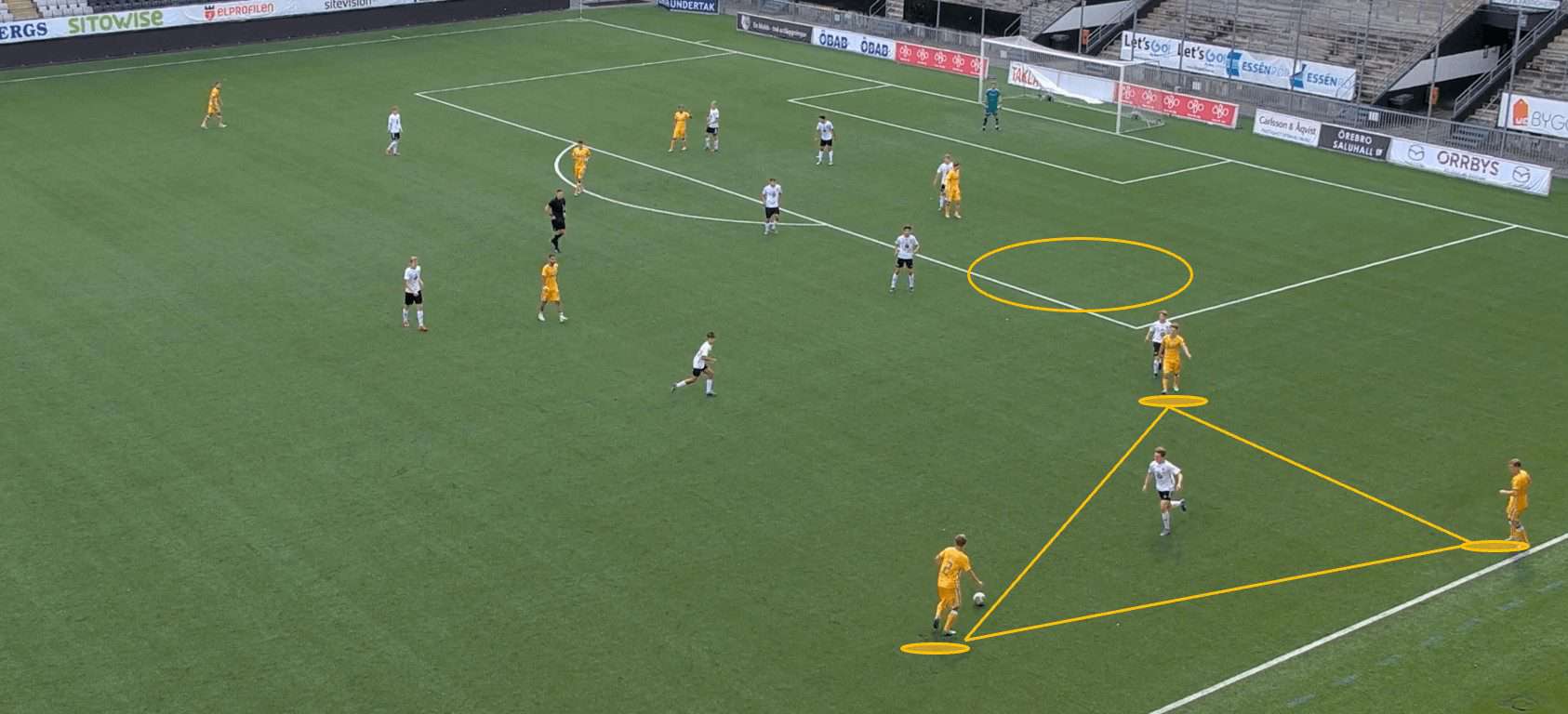
However, Göteborg’s attacking play does not purely revolve around pressing high and forcing turnovers. They look to build attacks methodically by stretching the play via both full-backs pushing up and the wingers staying very wide, almost playing on the touchlines.
We can see here that they like to initiate quick link-up play in the wide areas, with the primary aim of drawing the opposition out of their defensive structure. By involving wide players in intricate passing combinations and quick exchanges of play, Göteborg U19s can force the opposition to spread their defensive structure, thereby creating openings in the central zones that can be exploited by attacking players making passes and runs into the box.
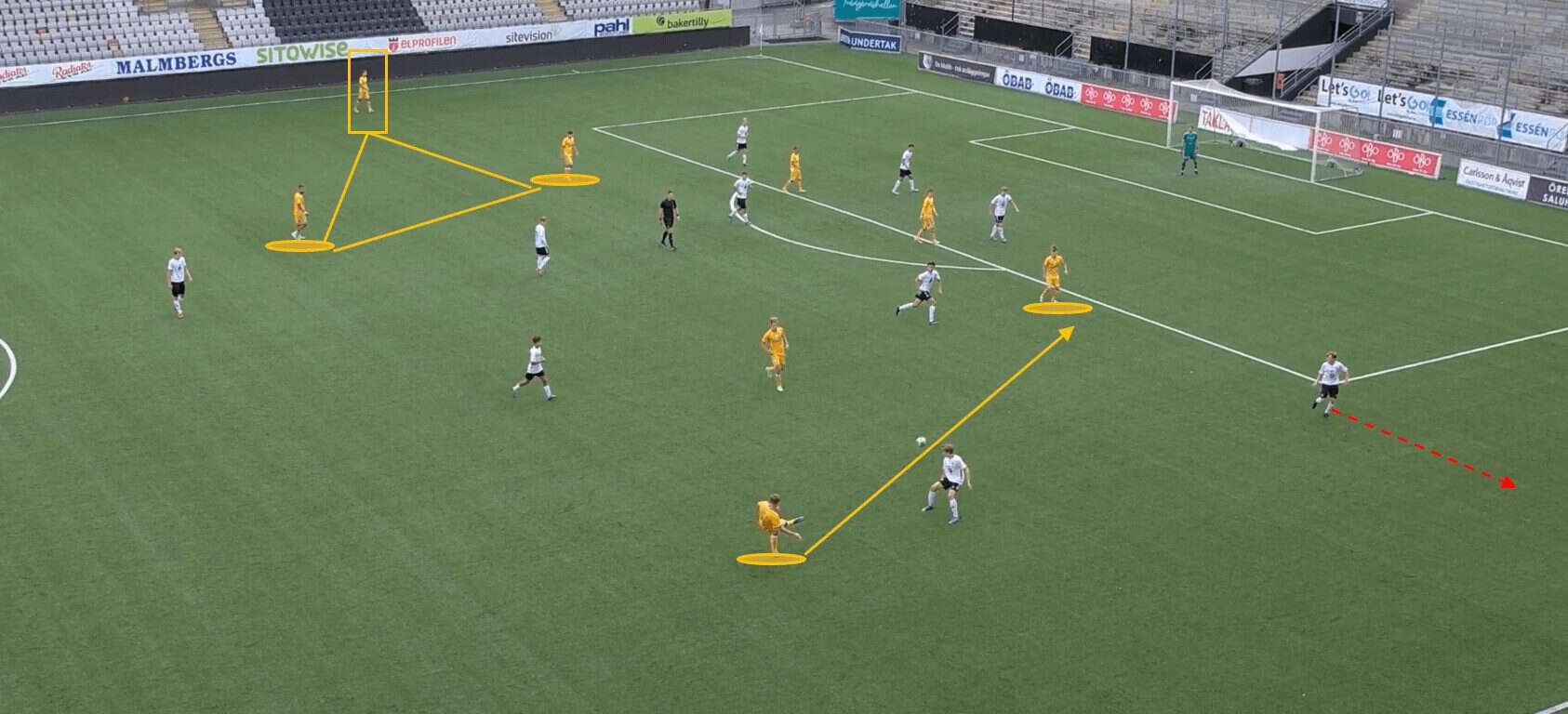
This is a good example to show the effectiveness of Göteborg’s attacking play. Firstly, the winger stays wide, drawing the opposition full-back out to press. Hampus Heed can exploit the space by playing a pass into the feet of his teammate, who has moved into the gap left open due to the defender’s inclination to mark the wide player.
Additionally, if we cast our eye over to the far side of the pitch, we can see that a similar shape is emerging in terms of the Göteborg player’s positioning. This indicates that a similar sequence of events would take place should the play be switched across to the left flank. The manipulation of the opposition’s defensive positions allows Göteborg to capitalise on their disorganisation and vulnerabilities.
Going long
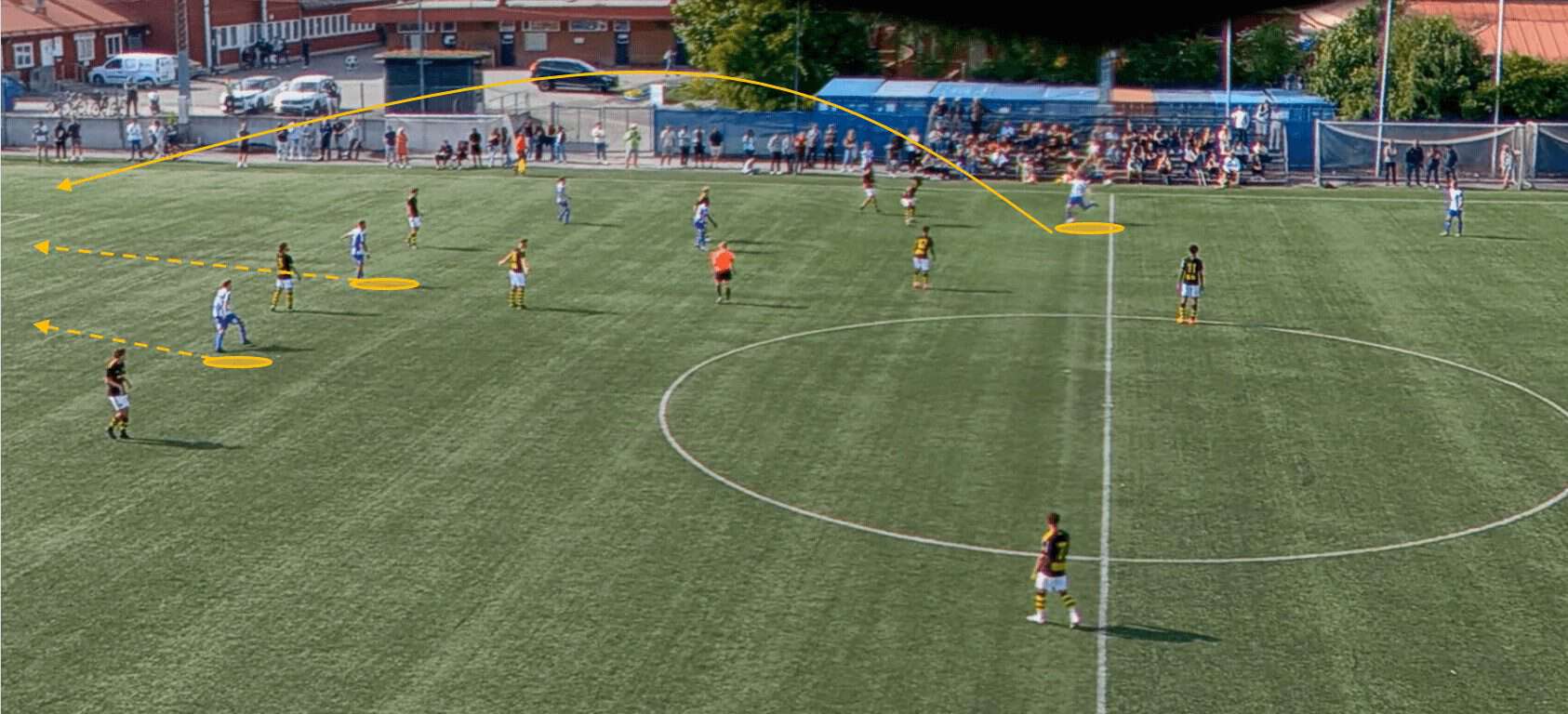
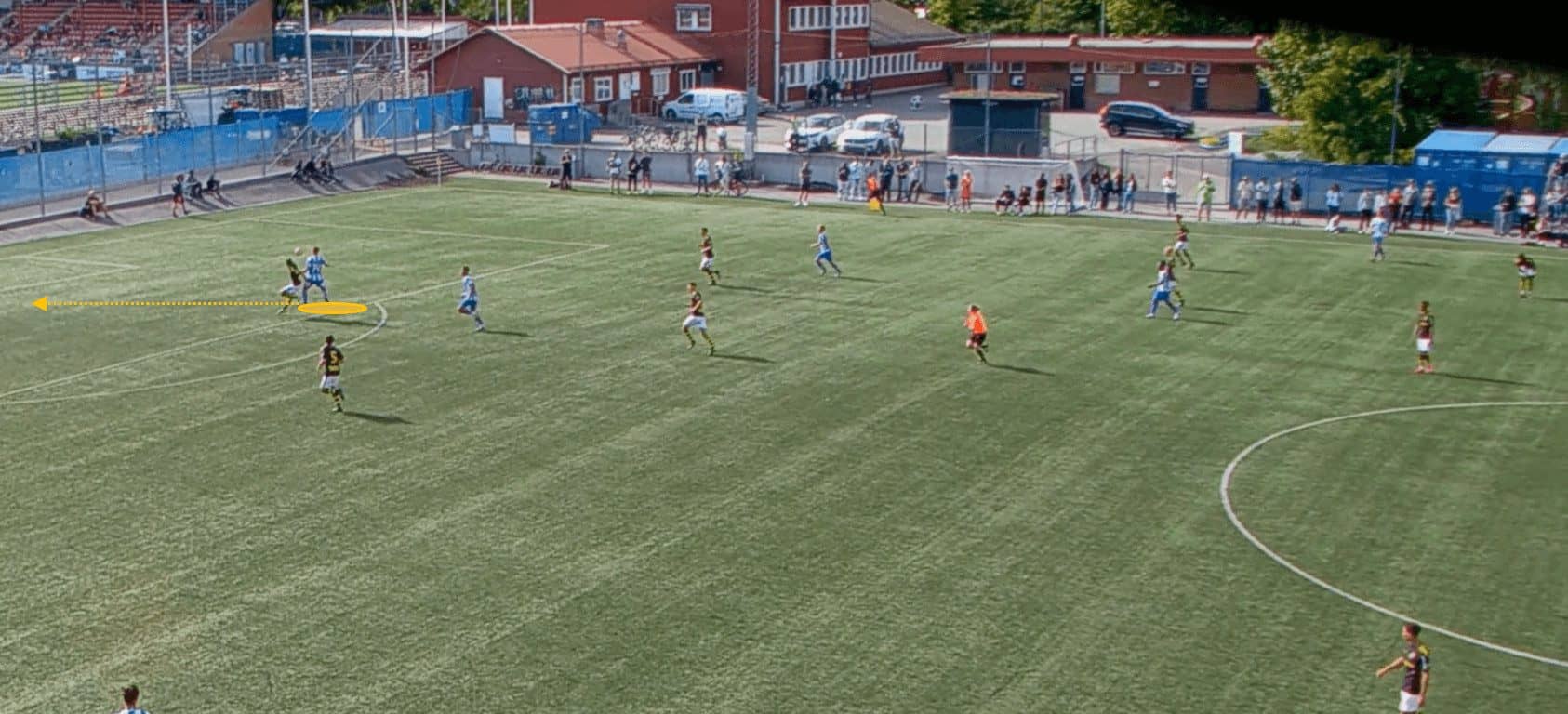
Although their primary aim is to create goalscoring opportunities via the medium of intricate build-up play and intelligent off-the-ball movement, Göteborg are not averse to going long when they need to. The example above demonstrates how the forwards are more than willing to run in behind the opposition defensive line.
The long ball is played over the top into the path of Vilmer Tyren, who does well to get it under control. The young forward then uses his strength to outmuscle his opponent and fire the ball into the net.
These long passes over the top utilise the Göteborg attackers’ speed and off-the-ball movements. The forwards can use their acceleration and agility to exploit the space in behind the defensive line. By timing their runs effectively, these players can position themselves to take advantage of goalscoring opportunities.
Mohib’s midfield magic
Midfielder Mohib Khalaf has been key for Göteborg U19 this season due to his ability to relentlessly press the opponents and his quick thinking and skillfulness when in possession.
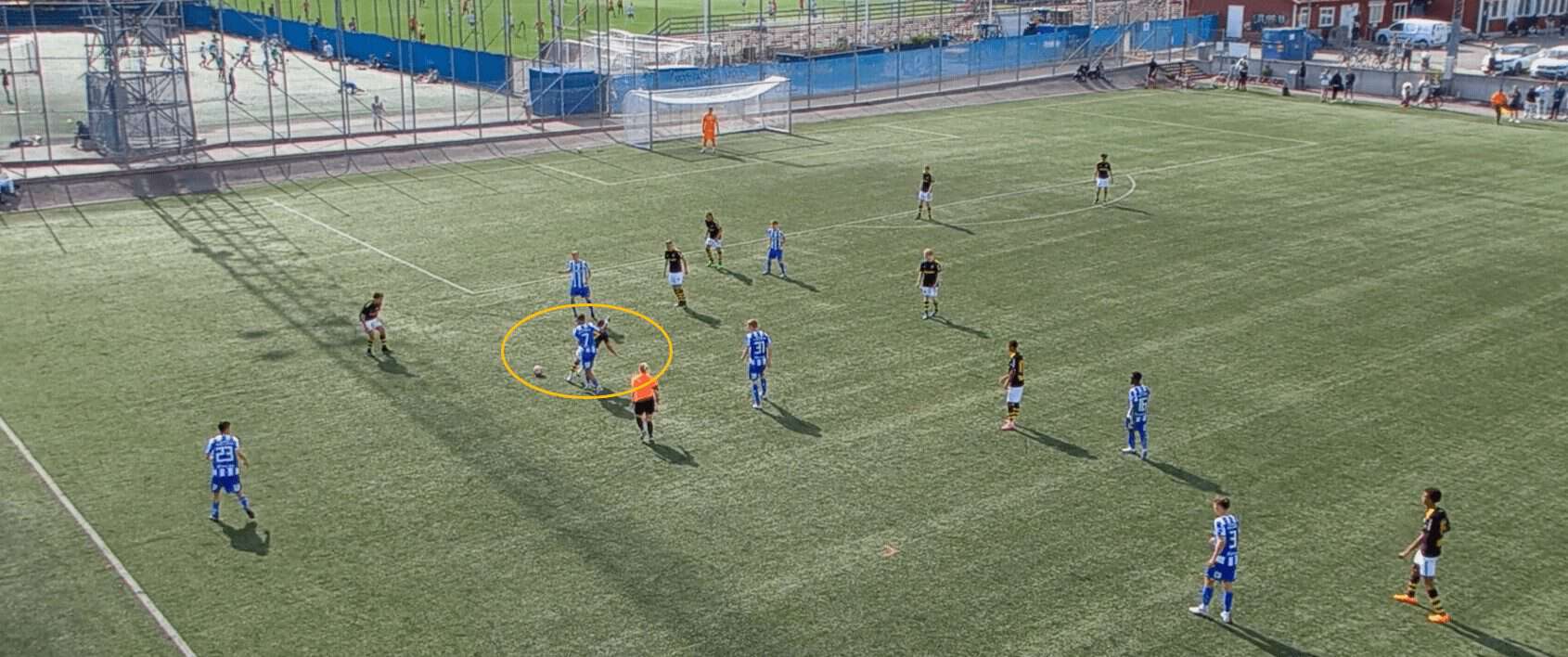
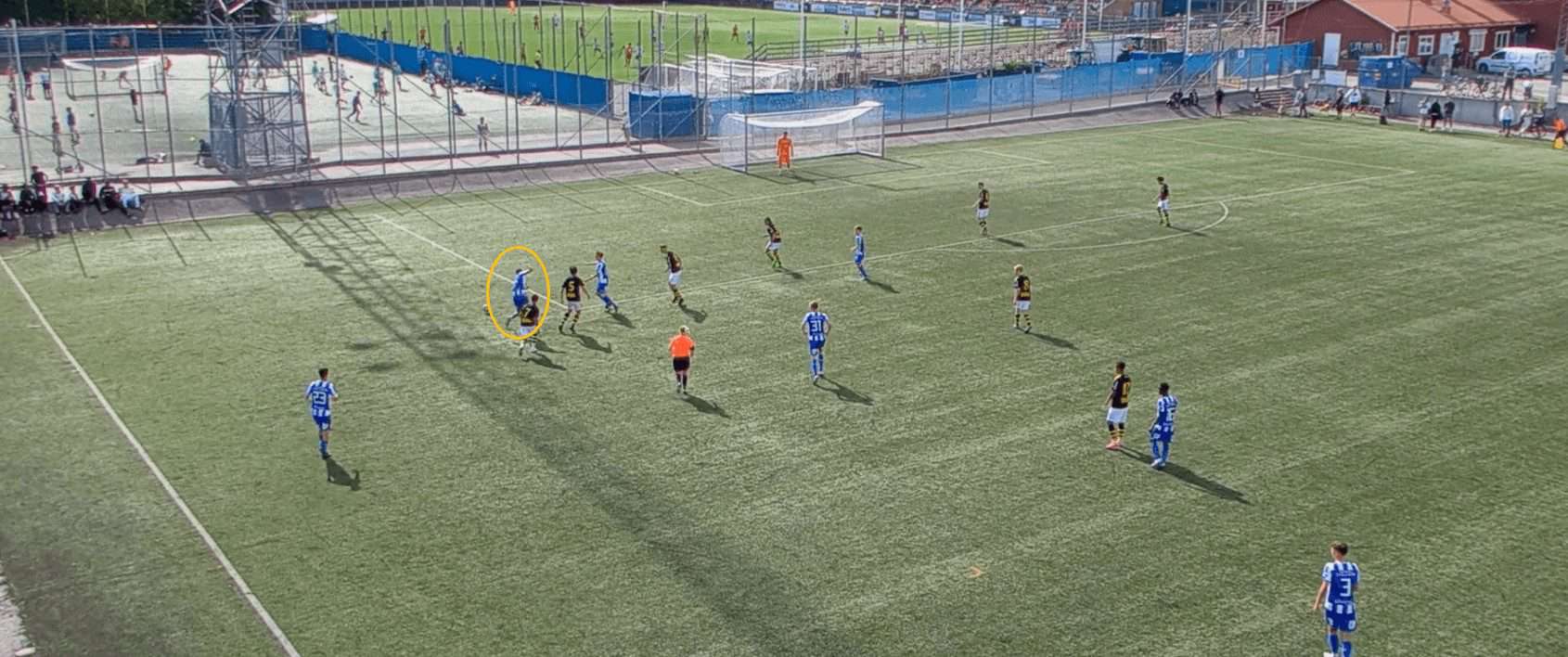
Here, we can see this in action as he battles to regain possession high up the pitch. Khalaf works hard defensively, averaging 0.93 tackles per 90 and will rarely shy away from a physical battle. He possesses very quick feet and can weave his way in and out of opposition challenges. The midfielder likes to work in the half spaces and will often look to put crosses in when possible, averaging 3.9 per 90.
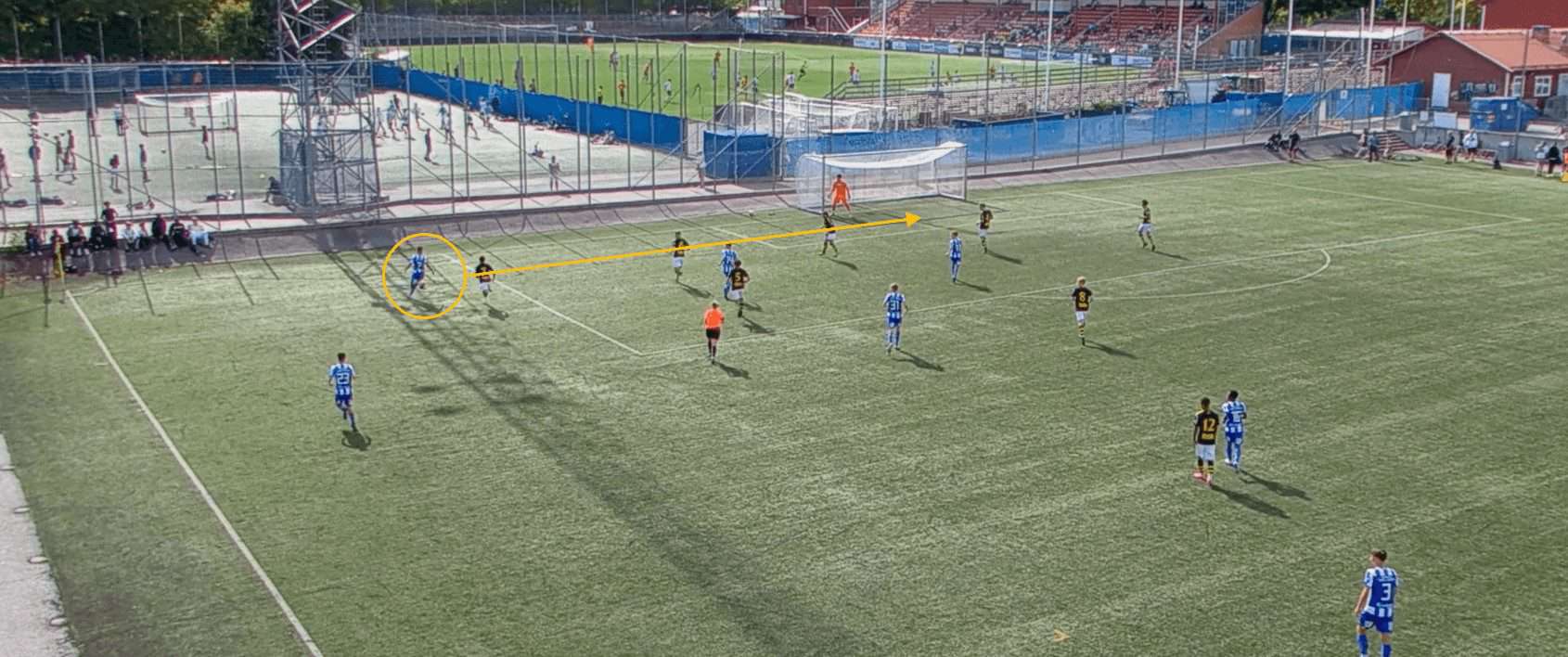
We can see this crossing ability in action here; he uses a good burst of acceleration to create space for himself and whips an excellent cross into the box. He is a vital player for Göteborg, capable of producing key passes at important points in the game.
Conclusion
In this analysis, we have looked at the tactics used by both Norrköping and Göteborg Under 19’s as they have been two of the standout teams in this year’s U19 Allsvenskan. Both clubs have a vast history of giving opportunities to their youth players, so it surely won’t be long before we see some of these talents stepping out for their respective first teams.
Norrköping’s resolute defence has seen them climb to the top of the table and gain the advantage over their rivals in this season’s title race. However, Göteborg have been incredibly entertaining due to their relentless pressing and outstanding build-up play. Overall, it has been a fantastic season at Under 19 level in Sweden, and both teams have put in some impressive performances.





Comments